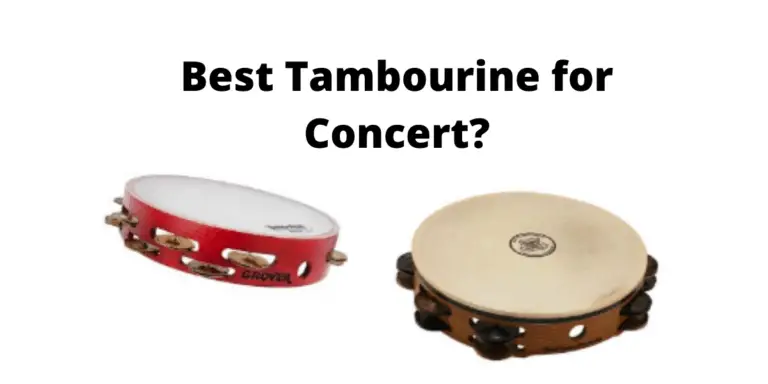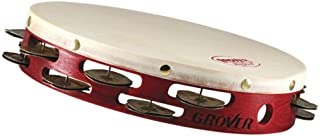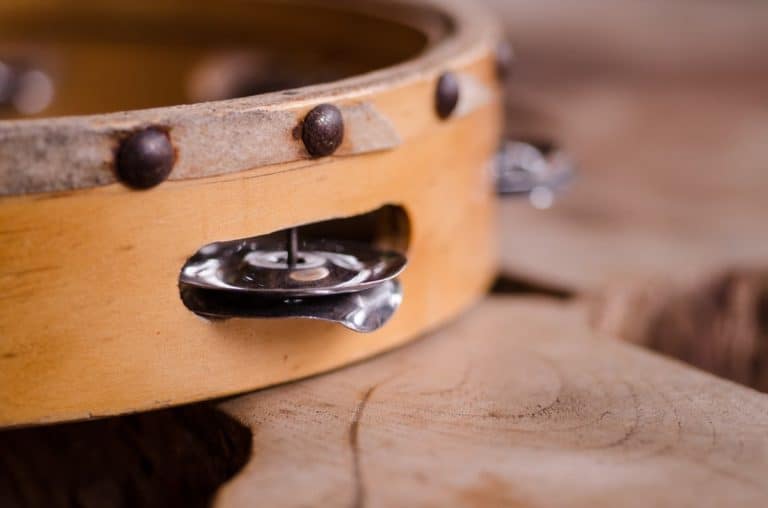Tambourine vs. Pandeiro (Comparison) A Pandeiro is NOT a Tambourine!
For someone just discovering Tambourine, it may be that you are doing so after seeing someone playing a Pandeiro. If you are just discovering Pandeiro than almost certainly the latter is true. They are very similar in look and for the uninitiated, it’s a very easy and forgivable mistake, but the two are very different. I hope this article provides an excellent comparison resource if you are considering your first Tambourine or pandeiro purchase.
What’s the difference between a Tambourine and Pandeiro? – The major difference between a tambourine and a pandeiro is the class of instruments they belong to. A tambourine is an untunable hand percussion instrument whilst a Pandeiro is classed as a type of Frame Drum whose head tension can be adjusted for ‘tuning’ And then there are the jingles.
I was surprised to find little information on the internet as to the differences between these two instruments so join me as I take a deeper look into the difference between the Tambourine and Pandeiro, where they are used and which is best suited for what you are looking for.
You can skip to my recommended pandeiros and tambourines page if you are short of time, but do come back and find out more on this page

The tambourine will be mostly made of wood, with or without head with set tension with varying numbers and rows of jingles. The tambourine can also be headless.

The Pandeiro has fewer jingles, typically 5 or 6, but the big difference is the ability to change the tension of the head and therefore the sound.
Best Tambourines and Pandeiros
Before reading on be aware that I do go into some depth across a range of comparisons and this will be a bit of a read. For a shortcut, I do have a page of recommended instruments that highlight my experience and recommendations for both starter instruments and the best value professional tambourines and pandeiros available online.
How to Choose Between a Tambourine or Pandeiro
The instrument you choose to buy and use will depend mostly on what you want to achieve and the style of music you enjoy or want to play. Whilst both instruments look quite similar in construction, and in the way they are played there are differences to consider. Price is not hugely different between each,
Tambourine v Pandeiro Prices
Price is not hugely different between each. As with most musical instruments, ou will be getting what you pay for. Go cheap and you’ll have an instrument that plays and sounds less well than a more expensive choice. Also what can be achieved as you improve playing technique may be frustrating.
Don’t go Overboard on Price for your First Tambourine or Pandeiro
It is worth going in for a reasonable priced Tambourine or Pandeiro if you are looking for your first. Don’t go really budget, you want something you can learn and develop with and don’t want to be limited by a rubbish product. Get to grips and practice. If you find it is not the instrument for you, you may be able to sell it on and have not lost too much money.
This may mean that you need to consider a synthetic head instrument to begin with but don’t worry. Until you become more adept at playing the more advances technique the quality of head is not going to affect your playing very much.
A great beginners tambourine like this one will serve you well, and not cost the earth either.
As mentioned, going cheap may frustrate you quite quickly as your playing progresses, so here we have the REMO Lotus. It is a 10-inch frame, with 2 rows of 5 pairs of german silver jingles.
Be assured that the very best players would have started on an inferior instrument before investing in something more expensive to expend their playing skills. If they didn’t they may have had previous experience with other percussion instruments or frame drums and were expending their instrument portfolio.
Go professional once you’re sure or want to take your playing to the next level.
After a few months of learning to play, and perhaps joining up with other percussion players or even a band, then you may decide what you can achieve on your cheaper instrument will leave you wanting to upgrade to a more professional tambourine or pandeiro.
Just as you might begin playing guitar with a cheaper version, you will find that progress may plateau and an upgrade id required to move your technique and results forward.
Tambourine vs Pandeiro – Music Styles
Many times when you have listened to music, you may not have been aware one of these instruments was being played. If watching, the instruments can be quite a visual aspect and you will be more aware, but which style of music do each of these instruments usually appear? They are quite specific and given the ancient age of each of them, they play a huge part in the sound of various music styles.
Tambourine Music Style
What type of music is Tambourine used For? – A tambourine is hugely popular in Pop Music, almost essential for Gospel Music and is an integral part of the percussion section of most orchestras. You will also find Tambourines played in country and western music and especially folk music bands.
You’ll rarely find a Gospel church ensconced in music without one being played either on stage or within the congregation.
That awkward lead singer in the rock band who doesn’t quite know what to do with his hands in the musical break ina song will often be sem given a tambourine a good smash
Pandeiro Music Style
What Type of Music is Pandeiro used for? – Portuguese in origin it arrived in Brazil with the first settlers, it goes without saying that the Pandeiro is an integral part of the Samba sound. Samba permeates into South American and Latin American popular music too, so it can be found in a great number of pop hits.
The beauty of a Pandeiro is unlike a tambourine the most skilled players can play this instrument on its own and produce some fantastic music that can not be achieved on the former. Ok, it is not the fullest sounds but more variation is available thanks to the small nuances that make it so different and more versatile.
Tambourine vs Pandeiro – What is the difference in Size?
Size matters right? Well absolutely yes, but probably more in tambourines than in Pandeiros. The larger the tambourine the more jingles and bigger sound you will create and whilst the same is true with the pandeiro, the greater flexibility, and narrower music style requirement, the available range will not be as broad.
The range of jingles that come with the tambourine will also make a big difference to the sound and volume that can be produced. Those rolls can be bigger and more dominant and the head strikes will have more prominence. But also, the larger head provides a bigger range of strike variation too.
So yeah, you want to go loud? Go big!
Tambourine Size
What Size is a Tambourine? – Tambourines are available in a large range of sizes. from 5-12 inches would be the most typical diameters. The smaller ones are not necessarily for kids although ideal but can produce different sounds depending on what is required.
Pandeiro Size
What Size is a Pandeiro? – A Pandeiro is typically based on a wooden or Formica rim of 8-12 inches. It can often be quite shallow and house a single row of metallic platinelas constructed of steel, copper or brass. Beginners would start with a smaller instrument due to the weight.
Tambourine v Pandeiro – What is the difference in Jingles?
The jingles found on both tambourines and pandeiros can differ greatly both in construction and number. Positioning will always be in the ring. Tambourine jingles are usually flatter whilst platinelas on a pandeiro will be cupped.
Tambourine Zills
How Many Jingles on a tambourine? – Know as ‘zills’, the number you will find on a tambourine can vary quite widely depending on the instrument and its design. From single rows of 6-12, to double rows of the same number. The more jingles the louder the potential of the instrument and the better it is suited to various styles of music.
Pandeiro Platinelas
How Many Jingles on a Pandeiro? – As a general rule of thumb, you will expect to find 5 pairs of platinelas on a 10″ Pandeiro whilst the 11″ version will have six and so on. They are constructed in a cupped form which provides a shorter sustain and is different in that respect from the flatter types found on a tambourine
Tambourine vs Pandeiro – What is the difference in Head Material?
Plainly I am using headed tambourines for this comparison, but remember that there are headless tambourines available that are covered in other areas of this website. So, back to the topic. Do the heads of Tambourines and Pandeiros differ. The answer is yes, as both can have natural skin heads or synthetic materials used.
Tambourine Head Material
Lower budget tambourines will most certainly have a synthetic head material, so power up and get into the natural skin heads but expect to pay more. The benefit of a better quality head will be instantly recognizable in sound quality and control of playing softer and sharper strikes.
Pandeiro Head Material
The ideal material used to create the head of the Pandeiro is a natural goatskin. The advantage of a better material is obvious when considering the ability to adjust the tension of the head for different head sound production. Whilst advances in synthetic materials are abound, there is no better choice than the original materials used by the Portuguese settlers when bringing the Pandeiro to South American shores.
My Experience with Tambourines and Pandeiros
I did not discover the pandeiro until a fair time after tambourines. As with most things I take an interest in, I was, or am for that matter, the most technically gifted percussionist, but I always like a challenge and when I first saw and heard the pandeiro being played couldn’t understand why my tambourine would never sound like that.
Closer inspection told me everything I needed to know in that I was looking and listening to a very different instrument. one that was plain to the eye and the ear something that could produce a great more versatility. The fact that this was also my first discovery of Samba music, which I love and the change was imminent.
I am almost certainly a poorer pandeiro player than a tambourine player, mostly down to my lack of dexterity, I could never get my fingers up and down a guitar fretboard either, although lack of dedication to practice will have played a greater part.
My Pandeiro has been gathering dust for some time, but writing this article has given me the impetus to grab it out and pick it up again. It may take a while to get back into it. I will see how it goes.
Anyway, whichever way you choose to go, I hope that you have found this comparison interesting if not informative. If you are searching for more information on either instrument and have come across this article I hope it has answered some questions that don’t seem to be directly answered anywhere. If you have found it a helpful resource I appreciate any shares for likeminded people you think it might help or in beginners groups you may be a part of.
And don’t forget, my recommended instruments page with more info on specific tambourines and pandeiros available online for both entry-level, or more experienced players. Ranging from wooden and Formica frames to Synthetic and Natural skin head options.
All the best!
Related Questions
What type of instrument is a tambourine?
The tambourine is a percussion instrument belonging to the head percussion class. It is a small frame with or without a head/skin, generally circular in shape and between 5-12 inches in diameter. In all cases, a tambourine will include at least one row of jingles, known as zills made of the metallic source to produce sound to accompany and head striking.
Is a Tambourine tuned or untuned?
It is not tuned but will have a specific pitch based on the tension of the head. Different head materials and tensions will differentiate the pitch of the head strikes of a tambourine which may change slightly with time and wear but are not adjustable without the complete replacement of the head. Different jingles may also be a part of the sound, pitch or ‘tune’ of a tambourine.
What is the pandeiro made of?
Most commonly a pandeiro will have a wooden frame, sometimes Formica but a natural material will always be best. The head will be a natural skin in the better instruments or synthetic substitutes otherwise, whilst the jingles, ‘platinelas’, will be constructed of copper, brass or steel and arranged in five or six pairs around the frame.
What other instruments are used in Samba music?
The pandeiro is famously used in samba music, so it will be played alongside snare drums, tamborims, surdos, agogo bells, and don’t forget a whistle. Samba is not amba without a whistle!!
Can you tune a pandeiro?
You absolutely can tune a pandeiro by affecting the tension of the head. A natural skin head will allow you to tune quite low whilst conversely a synthetic head can be tuned higher. The thicker the head the lower it is possible to go. How you go will be down to personal preference, or requirement for the music being made.




![Best Percussion Instruments For Kids [That you can play too]](https://cdn-0.coolpercussion.com/wp-content/uploads/2020/09/woman-4010110_1920-768x512.jpg)

![Tips for Recording Tambourine [Instruments – Microphones]](https://cdn-0.coolpercussion.com/wp-content/uploads/2021/02/recording-tambourine-768x512.png)

